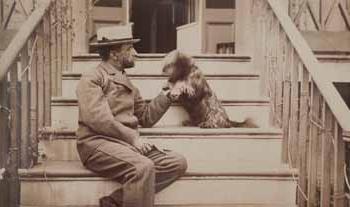By Emilie Haertsch, Publications
For all the importance and notoriety of Henry Adams’s book The Autobiography of Henry Adams, it contains one glaring omission: Henry’s wife Clover Adams is not mentioned once. Natalie Dykstra’s new biography, Clover Adams: A Gilded and Heartbreaking Life, attempts to rectify this by shedding light on the life and work of a remarkable 19th-century woman. This is no dry, esoteric biography, but an engaging, enjoyable read for the scholar or layperson alike.
 Marian Hooper Adams was nicknamed “Clover” by her mother, who felt that her daughter’s birth was a lucky occurrence. Born into a wealthy, prominent Boston family, Clover was raised in privilege and highly educated. Her mother died when she was five, but Clover remained very close to her father for the rest of her life. In 1872, at the age of 28, she married the historian Henry Adams, who was teaching at Harvard. After five years they moved to Washington, DC, residing near the White House, and began hosting an exclusive salon of politicians, writers, and thinkers. Despite this stimulation, Clover and Henry were bored, and the spark went out of their marriage. Their problems intensified due to the fact that they were unable to have children.
Marian Hooper Adams was nicknamed “Clover” by her mother, who felt that her daughter’s birth was a lucky occurrence. Born into a wealthy, prominent Boston family, Clover was raised in privilege and highly educated. Her mother died when she was five, but Clover remained very close to her father for the rest of her life. In 1872, at the age of 28, she married the historian Henry Adams, who was teaching at Harvard. After five years they moved to Washington, DC, residing near the White House, and began hosting an exclusive salon of politicians, writers, and thinkers. Despite this stimulation, Clover and Henry were bored, and the spark went out of their marriage. Their problems intensified due to the fact that they were unable to have children.
 Clover had always been interested in art and she found an outlet for her frustrations in a new camera in 1883. She learned the painstaking development process and began to take photographs of people, landscapes, and animals (she was a great lover of dogs and horses). Although a few of her photographs show traces of humor, including those of her dogs posed at a table set for tea, many of Clover’s photographs convey the melancholy and isolation of her own experience.
Clover had always been interested in art and she found an outlet for her frustrations in a new camera in 1883. She learned the painstaking development process and began to take photographs of people, landscapes, and animals (she was a great lover of dogs and horses). Although a few of her photographs show traces of humor, including those of her dogs posed at a table set for tea, many of Clover’s photographs convey the melancholy and isolation of her own experience.
In the spring of 1885, Clover’s father died, and her emotional state worsened. In December of that year she took her own life by drinking a chemical used in processing photographs. She was 42 years old. Although Henry Adams rarely spoke of his wife after her death, he commissioned the sculptor Augustus Saint-Gaudens to produce a memorial at her gravesite in Rock Creek Cemetery. Saint-Gaudens created a sculpture of a mysterious shrouded, seated figure, which still receives many visitors today and helped inspire Natalie Dykstra to begin researching this book.
Dykstra is an associate professor of English at Hope College in Holland, MI, and she received a National Endowment for the Humanities fellowship for her work on Clover Adams. A Fellow of the Massachusetts Historical Society, Dykstra did much of the research for her book at the Society, and she guest-curated the Society’s current exhibit, A Gilded and Heartbreaking Life: The Photographs of Clover Adams. The exhibit is free and open to the public and runs through June 2nd.

